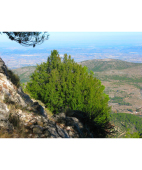
LIFE Project: Conservation and restoration of relict forests of Taxus baccata
- Type Project
- Status In progress
- Execution 2021 -2026
- Assigned Budget 2.406.410,00 €
- Scope Europeo
- Autonomous community Comunitat Valenciana
- Main source of financing LIFE
- Project website Web del proyecto
The LIFE Teixeres project aims to improve the conservation status of the Mediterranean Taxus baccata forest habitat and its resilience to major threats. The project will be implemented in 10 Natura 2000 sites where this habitat type is present, distributed across 84 sites and covering an area of 130 hectares.
The Mediterranean yew forest is a Natura 2000 priority habitat (9580*) of extremely limited extent and with serious conservation problems. Yew forests (Taxus baccata) are relict formations that are in serious decline throughout their distribution area. The European Environment Agency states that their current conservation status, “structures and functions,” and “future outlook” in the Mediterranean biogeographic region is U2 ('Unfavorable-poor').
In the Valencian Community, yew forests are found in the highest Mediterranean mountains, occupying the most humid ravines and the bases of north-facing slopes, often in rocky areas. These forests barely exceed one hectare and, for the most part, are interpreted as remnants of larger yew communities, progressively reduced and destroyed by a combination of human actions and climate change.
The main current threats are:
1) very small, scattered and fragmented habitat patches.
2) low seed productivity and seedling recruitment.
3) herbivory and trampling by domestic and wild ruminants.
4) climate change.
5) Forest fires. The low forest cover and fragmented distribution are the result of historical human activities over the past few centuries, such as land conversion for agriculture and grassland, forest uses, and overgrazing. Until the 1980s, the removal of understory and non-productive woody species as competition for productive species was a common forest management practice. Furthermore, the abandonment of marginal mountain lands during the last century allowed for rapid development of forest cover, generating very high densities that competed for resources with yew habitat and increased the risk of forest fires.
- Increase habitat coverage of small yew populations through reintroductions and/or reinforcements of existing populations to establish the minimum viable population in the most vulnerable locations.
- Reduce habitat fragmentation by implementing actions in appropriate sites (based on historical data, current distribution and ecological ranges of species, and distance from the nearest natural populations).
- Reduce competition through forest management. Many of the sites have been abandoned following human management and colonized by pioneer tree species. Reducing their density and biomass will have the secondary benefit of increasing their resilience to forest fires.
- Passive defense measures may include reducing herbivory and trampling by large ruminants by means of fencing or protecting individual plants.
- Collection and storage of germplasm in the CIEF seed banks (Valencia).
- Plant production in nurseries.
- Updating knowledge through a monitoring program for areas and habitats of interest, which will include preliminary assessments and monitoring throughout all stages of the project. This will be supported by maps and field data on the plant and animal communities living in the habitat of interest, as well as climatic conditions recorded by local weather stations.
- Communication through Social media and websites; project information brochures and newsletters; technical reports and scientific articles; and dissemination of project objectives and key issues related to the conservation of native flora and the Natura 2000 network at local and international events. These events will be open to local residents and key stakeholders.
- Awareness-raising campaigns targeting key stakeholders (e.g., forest owners, mountain sports organizations, conservation NGOs, and volunteers) to reduce habitat pressures.
- A report with the indicators and the methodology for measuring them. Stakeholders will be identified and involved.
- Submission of project plans for conservation actions.
- 230 ha of habitat type improved through forest treatments that will reduce competition from native and introduced tree species, and at least 10 ha of habitat protected from herbivores.
- Six Taxus baccata seed lots and at least one lot of 10 other habitat-type companion species. Twelve living Taxus collections have been installed, at least one per SCI. Each of these clonal orchards will include approximately 100 seed-producing female yew trees and 20 male trees for pollination, and will have an average area of 0.5 ha.
- At least 28,000 plants of 37 different species to be transplanted (some site-specific species, others common throughout the project area).
- Habitat restoration by restoring the appropriate species composition through the planting of 23,000 plants. The remainder will be used for replanting and environmental education activities.
- A report on the assessment of habitat improvement and at least one scientific article.
- Evaluation of the quality of collected seed batches. | Reports on the impact of outreach activities, the overall success of the project, and the socioeconomic impact.
- At least three technical seminars in Valencia. Organization of an international conference coinciding with the biannual GENMEDA general conference focused on the conservation of yew habitats in the Mediterranean and the development of a best practices manual.
- Networking activities to exchange information, experiences, and best practices with similar LIFE projects and institutions.
- Coordinator/entity name: Emilio Laguna Lumbreas
Postal address: C/ de la DEMOCRACIA 77; Cdad Adva. 9 d'Octubre -Tower 1 - Floor 3, 46018, Valencia,
The project is aligned with the EU Habitats Directive, the EU Biodiversity Strategy for 2030, the EU Green Deal, and the new Forest Strategy by restoring the target habitat, increasing forest resources, and improving their health and resilience.
- Generalitat Valenciana/Conselleria de Agricultura, Desarrollo Rural, Emergencia Climática y Transición Ecológica
- VAERSA(Valenciana d'Aprofitament Energètic de Residus S.A.)







